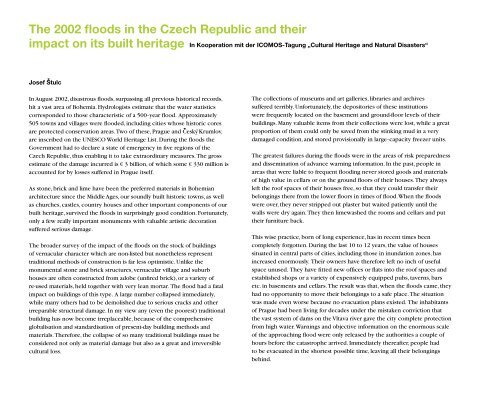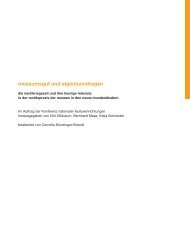Sicherheit und Katastrophenschutz für Museen, Archive
Sicherheit und Katastrophenschutz für Museen, Archive
Sicherheit und Katastrophenschutz für Museen, Archive
Erfolgreiche ePaper selbst erstellen
Machen Sie aus Ihren PDF Publikationen ein blätterbares Flipbook mit unserer einzigartigen Google optimierten e-Paper Software.
The 2002 floods in the Czech Republic and their<br />
impact on its built heritage<br />
Josef Stulc<br />
In August 2002, disastrous floods, surpassing all previous historical records,<br />
hit a vast area of Bohemia. Hydrologists estimate that the water statistics<br />
corresponded to those characteristic of a 500-year flood. Approximately<br />
505 towns and villages were flooded, including cities whose historic cores<br />
are protected conservation areas. Two of these, Prague and Cesky ´<br />
Krumlov,<br />
are inscribed on the UNESCO World Heritage List. During the floods the<br />
Government had to declare a state of emergency in five regions of the<br />
Czech Republic, thus enabling it to take extraordinary measures. The gross<br />
estimate of the damage incurred is € 3 billion, of which some € 330 million is<br />
accounted for by losses suffered in Prague itself.<br />
As stone, brick and lime have been the preferred materials in Bohemian<br />
architecture since the Middle Ages, our so<strong>und</strong>ly built historic towns, as well<br />
as churches, castles, country houses and other important components of our<br />
built heritage, survived the floods in surprisingly good condition. Fortunately,<br />
only a few really important monuments with valuable artistic decoration<br />
suffered serious damage.<br />
The broader survey of the impact of the floods on the stock of buildings<br />
of vernacular character which are non-listed but nonetheless represent<br />
traditional methods of construction is far less optimistic. Unlike the<br />
monumental stone and brick structures, vernacular village and suburb<br />
houses are often constructed from adobe (unfired brick), or a variety of<br />
re-used materials, held together with very lean mortar. The flood had a fatal<br />
impact on buildings of this type. A large number collapsed immediately,<br />
while many others had to be demolished due to serious cracks and other<br />
irreparable structural damage. In my view any (even the poorest) traditional<br />
building has now become irreplaceable, because of the comprehensive<br />
globalisation and standardisation of present-day building methods and<br />
materials. Therefore, the collapse of so many traditional buildings must be<br />
considered not only as material damage but also as a great and irreversible<br />
cultural loss.<br />
In Kooperation mit der ICOMOS-Tagung „Cultural Heritage and Natural Disasters“<br />
The collections of museums and art galleries, libraries and archives<br />
suffered terribly. Unfortunately, the depositories of these institutions<br />
were frequently located on the basement and gro<strong>und</strong>-floor levels of their<br />
buildings. Many valuable items from their collections were lost, while a great<br />
proportion of them could only be saved from the stinking mud in a very<br />
damaged condition, and stored provisionally in large-capacity freezer units.<br />
The greatest failures during the floods were in the areas of risk preparedness<br />
and dissemination of advance warning information. In the past, people in<br />
areas that were liable to frequent flooding never stored goods and materials<br />
of high value in cellars or on the gro<strong>und</strong> floors of their houses. They always<br />
left the roof spaces of their houses free, so that they could transfer their<br />
belongings there from the lower floors in times of flood. When the floods<br />
were over, they never stripped out plaster but waited patiently until the<br />
walls were dry again. They then limewashed the rooms and cellars and put<br />
their furniture back.<br />
This wise practice, born of long experience, has in recent times been<br />
completely forgotten. During the last 10 to 12 years, the value of houses<br />
situated in central parts of cities, including those in in<strong>und</strong>ation zones, has<br />
increased enormously. Their owners have therefore left no inch of useful<br />
space unused. They have fitted new offices or flats into the roof spaces and<br />
established shops or a variety of expensively equipped pubs, taverns, bars<br />
etc. in basements and cellars. The result was that, when the floods came, they<br />
had no opportunity to move their belongings to a safe place. The situation<br />
was made even worse because no evacuation plans existed. The inhabitants<br />
of Prague had been living for decades <strong>und</strong>er the mistaken conviction that<br />
the vast system of dams on the Vltava river gave the city complete protection<br />
from high water. Warnings and objective information on the enormous scale<br />
of the approaching flood were only released by the authorities a couple of<br />
hours before the catastrophe arrived. Immediately thereafter, people had<br />
to be evacuated in the shortest possible time, leaving all their belongings<br />
behind.







